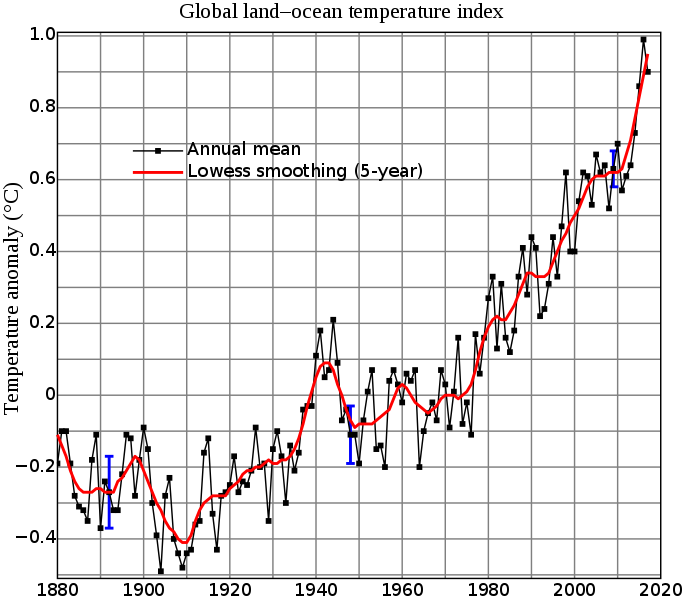According to the NOAA (National Oceanic and Atmospheric Administration) the year 2022 was the sixth hottest year since 1880 when modern temperature record-keeping began. Meanwhile, the last nine in the past 10 years were, since the 1880 (modern-era temperature record-keeping) date, have been the hottest. The NASA (National Aeronautics and Space Administration), has determined last year to be the planet’s fifth hottest year in modern recorded-temperature history.
Using the period of 1951 to 1980 as a reference base, temperature average at the Earth’s surface has risen roughly 1.1 degrees Celsius (C) above that 0-degrees-C reference point. Prior to the sharp rise, average global surface temperature had been mostly steady going back as many as 10,000 years, about the time the last ice age concluded – meaning it experienced comparatively minor variability.
This characteristic, if represented graphically, would resemble a hockey stick – one horizontally configured, compared to what one would see if watching a field or ice hockey game, where the player maneuvering the ball or puck around holds the stick in the typical near-vertical position. If greenhouse gas (GHG) emissions in this 10,000-or-so-year time span were likewise plotted, what would be revealed would be a similar-shaped plot – mostly flat, representing emissions output of the time between about 10,000 years and 250 or so years ago, and at the end, a shape characteristic of the ball- or puck-striking part of the hockey stick, that part pointing diagonally upwards, this, of course, reflecting exponential, unprecedented GHG-emissions output growth from the time going back 250 or so years ago to today. The evidence that supports this premise is incontrovertible.
Copernicus Climate Change Service in its Jan. 9, 2023 “Copernicus: 2022 was a year of climate extremes, with record high temperatures and rising concentrations of greenhouse gases,” press release, stated: “New data from the European Union’s Copernicus Climate Change Service reveals another year of climate extremes with many high temperature records and rising atmospheric greenhouse gas concentrations. Summer 2022 was the hottest on record for Europe and each boreal summer month was at least the third warmest globally. Overall, 2022 was the second warmest year on record for Europe, while globally it was the 5th warmest year according to the ERA5 dataset.”
It is interesting to learn what people in other parts of the world are observing and reporting.
2016 was the hottest year globally in modern times. That being said, what it says is that we are seeing surface temperature fluctuation. We have witnessed changes in atmospheric greenhouse gas emissions also. Such were somewhat diminished in 2020 due to the effect the pandemic had on global economic activity. The amount of GHG emissions output was lower. That condition was temporary and once years 2020 and 2021 passed, the GHG emissions output was back on its positive, upward track.
There is some good news in all of this. California, with its 40 million-person population, would have the world’s 5th largest economy, that is, if the state were its own country. But, regardless, whether country or state, California’s greenhouse-gas emissions output has seen fairly steady decline since reaching a high of 489 million metric tons of carbon dioxide equivalent (MMTCO2e) emissions in 2004, and falling to its current level of 404 MMTCO2e in 2020. All of this while state economic output, overall, has remained strong.
In other news, the NASA in March 2022 introduced to the public its “Climate Spiral” graphic. In reality, though, it is more a “temperature” spiral plot than it is a climate or weather plot. What it shows in time-forwarding or ascending time-sequencing fashion, is the global mean surface temperature change, starting in 1880 and stopping in 2022. It’s interesting because it shows how the Earth’s GMST has changed over that period, all relative to the 1951 to 1980 reference, which is represented in the graphical depiction as 0 degrees Celsius.
What it also shows is that much of the average temperature at the surface globally before 1950 falls between the 0-degrees-Celsius reference and the -1 degree Celsius lower limit. But, what is really amazing to see is the temperature change between 1980 and 2022 and all of it in the plus space – between 0 degrees C and the +1 degree upper reference and even past that, which is exactly what one, in observing this, would expect.
And, as I emphasized to the friend who brought this video presentation to my attention, it’s, without question, clear exactly what is happening here. It’s instructive if not interesting.
If you haven’t yet seen this video and want to, using your favorite search engine, type in “Climate Spiral” in the search field and then choose accordingly. Happy viewing!
– Alan Kandel
Copyrighted material.
Corresponding, connected home-page-entry image: NASA Goddard Institute for Space Studies
